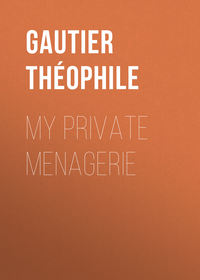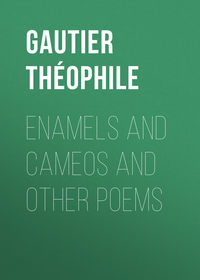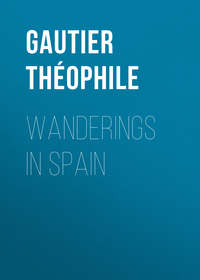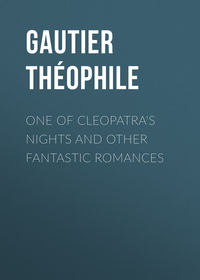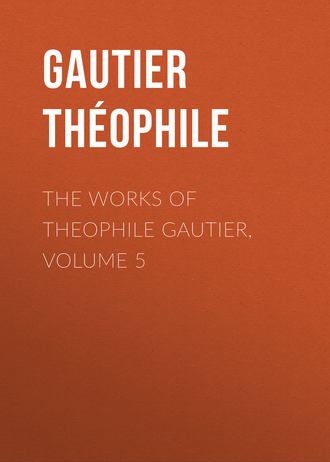 полная версия
полная версияThe Works of Theophile Gautier, Volume 5
The ancients, differing in this respect from the moderns, spent their life in preparing their last dwelling. The history of their funerals contains, therefore, the germ of their whole history. But that history, full of intimate details, mysterious facts, and documents at times enigmatical, is not to be written like the other form of history which men are satisfied to repeat from age to age. It is amazing how many years the author had to spend in study and research in order to write his book, to bring together his materials, to analyse and to compare them.
After having clearly defined what he means by archæology, the author enters upon his subject. Going back to the beginnings of the world, he depicts the amazement and the grief of man when for the first time he saw his fellow-man die. The entrance on earth of that unknown and terrible power which has since been called death is solemn and tragical. The body is lying there motionless and cold amid its brethren, who are amazed at the sleep which they cannot break, at the livid pallor and the stiffness of the limbs. Horror succeeds surprise when the signs of decomposition become visible. The body is concealed under leaves, under stones heaped up within caverns, and each one wonders with terror whether that death is an exceptional case, or whether the same fate awaits every one in a more or less distant future. Deaths become more numerous as the primitive family grows older, and at last the conviction comes that it is an inevitable fate. The remembrance of the ancestors, the apparition of their ghosts in the wonders of dreams, the anxiety as to the fate of the soul after the destruction of the body, give rise, along with the presentiment of another life, to the first idea of God. Death teaches eternity and proves irrefragably the existence of a power superior to that of man. The belief in metempsychosis, in the migration of the soul, in other spheres, in reward and punishment according to the works done by men in the flesh, arose among nations in accordance with the degree of civilisation which they had attained. Among the least civilised these doctrines exist in a state of confusion, remain vague, uncouth, surcharged with superstition and peculiarities. Nevertheless, everywhere the mystery of the tomb is venerated.
It may be affirmed that no nation was so preoccupied with death as ancient Egypt. It is a strange sight to behold that people preparing its tomb from childhood, refusing to yield up its dust to the elements, and struggling against destruction with invincible obstinacy. Just as the layers of Nile mud have overlaid one another since the birth of time, the generations of Egypt are ranged in order at the bottom of the mummy pits of the hypogea and the pyramids of the necropolis, their bodies intact – for the worm of the tomb dare not attack them, repelled as it is by the bitter bituminous odours. But for the sacrilegious devastations of man, that dead people would be found complete, and its numberless multitudes might cover the earth. Imagination is staggered when it attempts to calculate the probable numbers; if Egyptian civilisation had lasted ten centuries longer, the dead would have ended by expelling the living from their native land. The necropolis would have invaded the city, and the stark mummies in their bandages would have stood up by the wall of the hearth.
You cannot have forgotten the marvellous chapter on "A Bird's-eye view of Paris," an amazing restoration by a poet, in which archæology itself, in spite of the progress it has made, would find it difficult to discover a flaw. Well, what Victor Hugo has done for mediæval Paris, M. Ernest Feydeau has attempted for the Thebes of the Pharaohs, and his restoration, as complete as it is possible for it to be, and which no historian had attempted, stands out before us as sharply as a plan in relief, and with all the perspective of a panorama. Thebes of the Hundred Gates, as Homer called it, – antiquity has told us nothing more about this ancestress of capitals; but M. Ernest Feydeau takes us walking with him through the city of Rameses; he shows us all its monuments, its temples, its palaces, the dwellings of the inhabitants, the gardens, the harbour, the fleet of vessels; he draws and colours the costumes of the people; he enters the harems, and shows us the travelling musicians, the dancers, the enslaved nations which built for the Egyptians, the soldiers manœuvring on the parade ground, the processions of Ammon, the foreign peoples which come seeking refuge and corn, the caravans of thirty-five hundred years ago bringing in the tribute. Then he describes the colleges of priests, the quarters inhabited by the embalmers, the minutest details of the embalming processes, the funeral rites, the construction of the thousands of hypogea and mummy pits which are to receive the mummies. Finally he shows us, passing through the streets of that strange city, the funeral procession of a royal scribe upon its catafalque, drawn by oxen, – the numberless mourners, the hosts of servants bearing alms and offerings. I regret that the length of that passage does not allow of my quoting it in full and enabling the reader to mark the union of a beautiful style with scientific knowledge. Unquestionably no modern traveller has ever given a more picturesque description of any existing city, Constantinople, Rome, or Cairo. The artist seems to be seated upon the terrace of a palace, drawing and painting from nature as if he were a contemporary of Rameses, and as if the sands had not covered with their shroud, through which show a few gigantic ruins, the city forever vanished. And yet he indulges in no chance supposition, in no rash padding. Every detail he gives is supported by the most authentic documents. M. Ernest Feydeau put aside every doubtful piece of information and all that appeared susceptible of being interpreted in more than one way. He seems to have been anxious to forestall the suspicious mistrust of scholars, who object to having the dry results of erudition clothed in poetic language, and who do not believe that a treatise on archæology can possibly be read with as much interest as a novel.
As I have said, the Egyptians have left us no books, and had they done so the art of deciphering hieroglyphics or even phonetic or demotic writing is not yet assured enough to allow of absolute trust being put in it. Happily the Egyptians performed a work of such mightiness that it amazes the beholder. By the side of the hieroglyphic inscriptions they carved on the walls of palaces and temples, on the sides of pylons, the faces of the corridors and the bays of funeral chambers, on the faces of the sarcophagi and on the stelæ, on the covers and the interior cartonnages of the mummies, – in short, on every smooth surface of rock, whether sandstone or granite, basalt or porphyry, with an ineffaceable line coloured with tints that the long succession of ages has not faded, – scenes in which we find in detail the habits and customs and the ceremonies of the oldest civilisation in the world. It seems as if those strange and mysterious people, foreseeing the difficulty which posterity would experience in deciphering their hieroglyphics, intrusted their translation to drawing, and made the hypogea tell the secret kept by the papyri.
Royal ceremonies, triumphal entries, the payments of tribute, all the incidents of military life, of agriculture, sport, fishing, banqueting, dances, the intimate life of the harem, all is reproduced in these endless paintings, so clearly drawn, with the difference in races, variety of types, shape of chariots, of weapons, of arms, of furniture, of utensils, of food, of plants, still clearly visible to-day. A maker of musical instruments could certainly make a harp, a lyre, or a sistrum from the pattern of those upon which are playing the female musicians at the funeral repast represented in one of the tombs of the necropolis of Thebes. The model of a dog-cart in a plate of modern carriages is not drawn more accurately than the profile of the chariot seen in the funeral procession of the ecclesiastical scribe of Amenoph III, a king of the eighteenth dynasty.
The author has not confined himself to these purely material details. He has examined the funeral papyri which, more or less valuable, are found with each mummy; he has carefully studied the allegorical signs which represent the judgment of the soul, the good and evil deeds of which are weighed before Osiris and the forty-two judges, and thus he has mastered the mysterious beliefs of the Egyptians on the question of the future life. The soul, whether it was conducted to Amenti or driven into the infernal regions – that is, towards the West – by the dog-headed monkeys, who appear to have been a sort of dæmons charged with the carrying out of sentences, – the soul was, nevertheless, not freed from all connection with the body; its relative immortality depended in some sort upon the integrity of the latter; the alteration, the deprivation of one of the limbs was supposed to be felt by the soul, the form of whose impalpable spectre would have been mutilated and could not have traversed, wanting a leg or an arm, the cycle of migrations or metempsychoses. Hence the religious care taken of the human remains, the infallible methods and the minute precautions of the embalmers, the perfect solidity and the secret location of the tombs, of which the priests alone possessed the plan, the constant thought of eternity in death which characterised in so striking a manner the ancient Egyptians and makes them a nation apart, incomprehensible to modern nations, which are generally so eager to give back to the earth and to cause to disappear the generations which have preceded them.
During his long and intimate acquaintance with Egypt, M. Ernest Feydeau, who is not only an archæologist but also a poet, after he had sounded the mysteries of the old kingdom of the Pharaohs, became passionately attached to that art which the Greek ideal – which nevertheless is indebted to it for more than one lesson – has caused us to despise too much. He has understood, both as a painter and a sculptor, a beauty which is so different from our own standard and which is yet so real.
Hathor, the Egyptian Venus, seems to him as beautiful as the Venus of Milo. Without entirely sharing that feeling, I confess to admiring greatly the clean outline, so pure, so slender, and so full of life. In spite of the hieratic restrictions which did not allow the consecrated attitude to be varied, art shows out in more than one direction. There is a beauty of a strange and penetrating charm foreign to our own habits in the heads with their delicate profiles, their great eyes made larger by the use of antimony, the somewhat thick lips with their faint, dreamy pout, or their vague smile resembling that of the sphinx, in the rounded cheeks upon which hang broad discs of gold, in the brows shaded by lotus flowers, in the temples framed in by the narrow tresses of the hair, powdered with blue powder, which are shown in funeral processions. How youthful, how fresh, how pure are the tall, slender bodies, the swelling bosoms, the supple waists, the narrow hips of these dancers and musicians who beat time with their long, slender fingers and their long, narrow feet. The Etruscans themselves have never produced anything more light, more graceful, and more elegant upon the bodies of their finest vases, and in more than one famous Greek bas-relief can be recognised attitudes and gestures borrowed from the frescoes of the necropolis and the tombs of Egypt. It is from Egypt also that Greece took, while diminishing their huge size, its Doric and Ionic orders and its Corinthian capital, in which the acanthus takes the place of the lotus flower.




